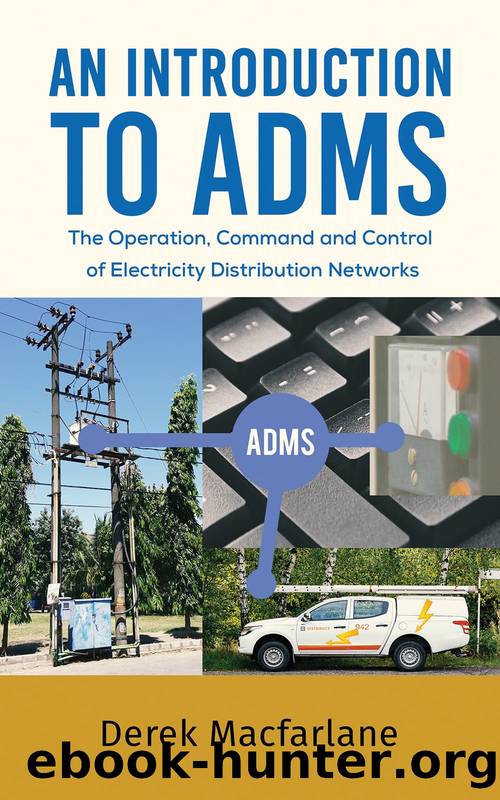An Introduction to ADMS by Derek Macfarlane

Author:Derek Macfarlane
Language: eng
Format: epub
Publisher: Austin Macauley Publishers
Published: 2021-10-12T00:00:00+00:00
Time Warp Errors in Customer Connectivity Updating
Customer connections, or more rigorously customer premise connectivity to the network also requires to be maintained. This data is problematical in that there are millions of connections, and updates occur at a rate usually proportional to the rate of development of the country. So an advanced western European country saw most of its electrification in the 1950s and 60s, and today experiences only a 1 to 2% change year on year. Whereas a third world country starting out on electrification might see connections growing at 7 to 12% per year. When an ADMS or a GIS project starts up there might be a deliberate exercise to capture the connectivity of premises, but this is not a dynamic methodology, it is a photograph at one moment in time, and a customer connections update procedure is needed to handle the incremental changes year on year thereafter. Even at 2% growth this represents 20,000 customer connectivity updated per year for a one million customer utility. The second aspect of this issue is the granularity of the connection. When this data was first required for OMS to operate, then groups of customers per secondary substation was sufficiently accurate to enable a crew to be sent to the correct substation to investigate. New functions and the introduction of local micro renewable generation, now require increased granularity down to particular sections of LV cable and the individual phase connection, so that load profiles of transformers can be accurately ascertained from smart meter data.
It is true that the effect of one customer connection missing is lost in the noise when there are one million customers connected. One must, therefore, ask if this is really necessary to drive up the accuracy of this data, when the only benefit was a negligible error impact on customer minutes lost and customer interruptions. In answer there are two reasons, the first is that, uncontrolled and unmonitored, this error in updating will grow over time and eventually the error will be sufficient to interfere with the accuracy of OMS outage predictions, and this will become evident during some time of stress on the data such as during a storm.
Secondly, new functions continued to be added to ADMS and, to be effective, some of these depend on low time warp errors and the increased granularity of customer connection data. For instance, load flow calculations at MV need minimised time warp error in reporting MV switching actions. Also LV load flow calculations on networks involving embedded micro renewable generation cannot be properly understood unless per phase customer connectivity data is available. This error will increase as more generation is connected, and this effect is driving the requirement for better LV network management. This per phase data does not exist in many utilities at all.
Customer connectivity can be updated via an ADMS interface to GIS. As the customer premise services are installed, that update can be sent into the DMS database as a âtrivialâ update not requiring the operations department to check or authorise its inclusion in DMS.
Download
This site does not store any files on its server. We only index and link to content provided by other sites. Please contact the content providers to delete copyright contents if any and email us, we'll remove relevant links or contents immediately.
The Art of Coaching Workbook by Elena Aguilar(50968)
Trainspotting by Irvine Welsh(21518)
Twilight of the Idols With the Antichrist and Ecce Homo by Friedrich Nietzsche(18501)
Fangirl by Rainbow Rowell(9095)
Periodization Training for Sports by Tudor Bompa(8168)
Change Your Questions, Change Your Life by Marilee Adams(7634)
This Is How You Lose Her by Junot Diaz(6780)
Asking the Right Questions: A Guide to Critical Thinking by M. Neil Browne & Stuart M. Keeley(5631)
Grit by Angela Duckworth(5512)
Red Sparrow by Jason Matthews(5390)
Paper Towns by Green John(5087)
Room 212 by Kate Stewart(5035)
Ken Follett - World without end by Ken Follett(4643)
Housekeeping by Marilynne Robinson(4335)
The Sports Rules Book by Human Kinetics(4288)
Double Down (Diary of a Wimpy Kid Book 11) by Jeff Kinney(4204)
Papillon (English) by Henri Charrière(4195)
The Motorcycle Diaries by Ernesto Che Guevara(4009)
Exercise Technique Manual for Resistance Training by National Strength & Conditioning Association(3955)
